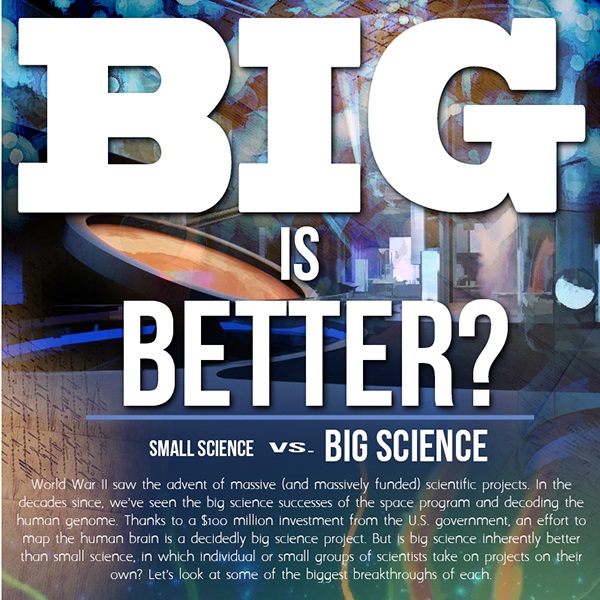Share this infographic on your site!
Embed this infographic on your site!
Big is Better?: Small Science vs. Big Science
World War II saw the advent of massive (and massively) funded scientific projects. In the decades since, we've seen the big science successes of the space program and decoding the human genome. Thanks to a $100 million investment from the U.S. government, an effort to map the human brain is a decidedly big science project. But is big science inherently better than small science, in which individual or small groups of scientists take on projects on their own? Let's look at some of the biggest breakthroughs of each.
Small science
Small science is performed on a small scale, often by a single individual. The discoveries and failures of small science often help to inform larger projects, in effect making small science a guinea pig for big science work. Small science is typically done at universities, providing students and young researchers with their first taste at real-world research.
Theory of special relativityA theory Albert Einstein developed as a hobby, quite simply, revolutionized our understanding of the very universe we live in. The 1905 paper that detailed the theory introduced a new framework for all of physics and proposed new concepts of space and time. As a result, we learned that space and time are interwoven into a single continuum known as space-time. Events that occur at the same time for one observer could occur at different times for another.
DNAJames D. Watson and Francis Crick first reported in 1953 the double-helix structure of DNA, creating a ripple effect on biology, particularly the study of genetics. Advances in molecular biology that stemmed from the DNA discover eventually led to ways to sequence the genes, which is central to modern medicine. The men eventually won the Nobel Prize for their discovery.
Cosmic microwave background radiationThe discovery by Arno Penzias and Robert Wilson that the entire universe is filled with thermal background radiation earned the pair the 1978 Nobel Prize and helped further mankind's understanding of the origins of the universe. In supporting the theory that the universe arose from a single, explosive event (the Big Bang), it's believed the radiation is the result of that event. Scientists are still engaging in research related to the discovery, and in March 2013, using an all-sky map of cosmic radiation, a team found the universe is slightly older than previously believed.
The transistorJohn Bardeen, William Shockley and Walter Brattain, working for Bell labs in the 1940s, created what many have called the most important invention of the 20th century -- the transistor. As the key active component in nearly all modern electronics, transistors can be found all over our world today -- in your computer, cellphone and car, just to name a few.
Big science
As its name implies, big science is done on a grand scale, often involving direct spending from governments or major nonprofit organizations. Thousands of researchers are involved and billions of dollars are spent on the projects.
The Manhattan project
Perhaps the first-ever big science project, led by the U.S. with support from the United Kingdom and Germany, produces the first atomic bombs of World War II. Under the direction of a U.S. Army general, the product, stretching from 1942-1946 the project eventually employed more than 130,000 people and cost nearly U.S. $26 billion (in today's dollars).
Space programLaunched by President Dwight Eisenhower in 1958, NASA's mission is to encourage peaceful applications of space science. Since it was founded, most American space explorations have been led by NASA, eventually sparking its most exciting moment, the 1969 landing of Apollo 11 on the surface of the moon. NASA's mission of exploring space continues despite budget cuts over the years; the agency recently scored another success with its Mars cover Curiosity. Today NASA employs more than 18,000 people and has a budget of $17.8 billion.
Mapping the human bodyA decade ago, the Human Genome Project successfully identified and mapped the 25,000 genes of the human genome, leading to a greater understanding of why our bodies are as they are and aiding in the treatment and prevention of diseases. Scientists from 18 countries participated in the research with a total cost of $3.7 billion over the project's 16 years. Scientists today hope to gain a similar understanding into the properties and functions of the human brain, through the BRAIN Initiative, with $100 million invested in a series of brain mapping projects.
Large Hadron ColliderThe largest and highest-energy particle accelerator in the world, the LHC took a decade to build near Geneva, Switzerland. Built by the European Organization for Nuclear Research (CERN), the collider's purpose is to allow physicists to test their theories, including the recently confirmed existence of the Higgs boson, the so-called God particle. Built in collaboration with 10,000 scientists and engineers from more than 100 countries, the collider cost about $9 billion, making it one of the most expensive scientific instruments ever constructed.
SOURCES
Oak Ridge National Laboratory
White House
NASA
AT&T


